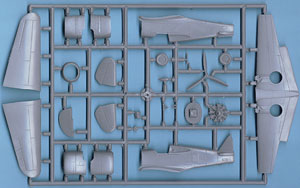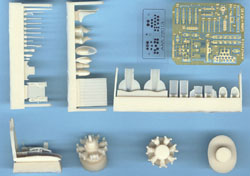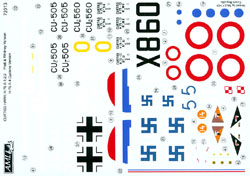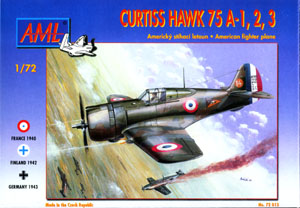AML's 1/72 Curtiss
Hawk 75A-1/2/3/4/6 | | History The Curtiss Model 75 was the beginning to a long fighter lineage. This diminutive radial-engined fighter marked the beginnings of the classic P-40 design which went on to fight on just about every front of the Second World War. The Hawk 75 received mediocre attention at home under the designation of P-36 but abroad is where it  really shone. British examples saw combat in South East Asia while those flown by Finnish pilots achieved great success against Russian planes. really shone. British examples saw combat in South East Asia while those flown by Finnish pilots achieved great success against Russian planes. The Kit I first reviewed the AML kit of the Curtiss Hawk 75 back in the July 2000 issue which was a Hawk 75A-4. This release uses the same plastic parts as that earlier release, but adds new resin and an absolutely gorgeous decal sheet. Rather than rehash my original review, I'll just outline the differences in the resin parts and cover the new decal sheet. The new resin pieces make up the different engines used in the different variants of the Hawk 75. The instructions do a very good job of outlining what you need to do for each specific variant. The rest of the resin pieces are the same as the original kit (making up the interior and other details).  What is really beautiful about this kit, though, is the decal sheet. There are a total of seven options provided, spanning all the major marks of the Curtiss Hawk 75. Countries provided are France, Finland, and Germany. Starting with France, the first example is a Curtiss Hawk 75A-1, No. 61, G.C. 1/5, flown by Staff Captain Alois Vasatko in January 1940. It is finished in the standard French three-color camouflage of khaki, chestnut brown, and dark blue-gray over light blue-gray. The markings include a number 14 in white on a black circle on the tail and the squadron emblem on the fuselage sides. The second French example is a Hawk 75A-2, No. 183 of the Bourges Polish Flight, flown by Lt. Colonel Haegelen in May of 1940. Like the first example, this one is finished in the French three-color camouflage, with a stork on the fuselage sides and the Polish emblem on the tail. The third French example is a Hawk 75A-3, No. 314, G.C. 1/4, flown by Cmdt. Stehlin out of Casablanca in 1942. This one is a Vichy machine and can be finished with either all-yellow or red/yellow striped cowling & tail surfaces. It also features a white stripe down the fuselage side, with the unit badge at the head of the stripe. Diagonal stripes are behind the canopy in red/white/blue. This example is probably the the most colorful of the French choices. What is really beautiful about this kit, though, is the decal sheet. There are a total of seven options provided, spanning all the major marks of the Curtiss Hawk 75. Countries provided are France, Finland, and Germany. Starting with France, the first example is a Curtiss Hawk 75A-1, No. 61, G.C. 1/5, flown by Staff Captain Alois Vasatko in January 1940. It is finished in the standard French three-color camouflage of khaki, chestnut brown, and dark blue-gray over light blue-gray. The markings include a number 14 in white on a black circle on the tail and the squadron emblem on the fuselage sides. The second French example is a Hawk 75A-2, No. 183 of the Bourges Polish Flight, flown by Lt. Colonel Haegelen in May of 1940. Like the first example, this one is finished in the French three-color camouflage, with a stork on the fuselage sides and the Polish emblem on the tail. The third French example is a Hawk 75A-3, No. 314, G.C. 1/4, flown by Cmdt. Stehlin out of Casablanca in 1942. This one is a Vichy machine and can be finished with either all-yellow or red/yellow striped cowling & tail surfaces. It also features a white stripe down the fuselage side, with the unit badge at the head of the stripe. Diagonal stripes are behind the canopy in red/white/blue. This example is probably the the most colorful of the French choices.
 For the Finnish options, you get three choices there as well. The first one is a Hawk 75A-4, CU-505 (with a Wright-Cyclone engine), of 1/LeLv 12. This is finished in dark green upper surfaces and light blue lower surfaces. The outer lower wing panels are painted yellow, as is a fuselage band behind the canopy. White scripted "CU-505" is written on both the rudder and the fuselage. The second Finnish Hawk 75 is actually the same as the first, just later in its life. This time it's been repainted in the black/olive green upper and blue-gray lower, with a yellow front half of the cowling. This one had been re-engined by this time and is now with a Pratt & Whitney Twin Wasp engine (and the requisite cowling changes). The final Finnish example is CU-560, a Hawk 75A-6 of 3/LeLv 31 in 1941. The camouflage is simple, being dark green over blue-gray, but the lower starboard wing was painted in black. Standard yellow markings are applied as well, with the cowling, fuselage band, and lower wing tips all being painted. A letter "O" is on the rudder, one side in white and the other in yellow. For the Finnish options, you get three choices there as well. The first one is a Hawk 75A-4, CU-505 (with a Wright-Cyclone engine), of 1/LeLv 12. This is finished in dark green upper surfaces and light blue lower surfaces. The outer lower wing panels are painted yellow, as is a fuselage band behind the canopy. White scripted "CU-505" is written on both the rudder and the fuselage. The second Finnish Hawk 75 is actually the same as the first, just later in its life. This time it's been repainted in the black/olive green upper and blue-gray lower, with a yellow front half of the cowling. This one had been re-engined by this time and is now with a Pratt & Whitney Twin Wasp engine (and the requisite cowling changes). The final Finnish example is CU-560, a Hawk 75A-6 of 3/LeLv 31 in 1941. The camouflage is simple, being dark green over blue-gray, but the lower starboard wing was painted in black. Standard yellow markings are applied as well, with the cowling, fuselage band, and lower wing tips all being painted. A letter "O" is on the rudder, one side in white and the other in yellow.
The final example is a Hawk 75A-2 in Luftwaffe service, being a former Vichy France plane. It's listed as being RLM 71 over RLM 65, with standard Luftwaffe crosses in all the usual places. Compared to the other choices on this sheet, this one is pretty bland, but it is also something not commonly seen, and will be an interesting addition sitting next to a Bf 109 or Fw 190. Conclusion If you want to build a Curtiss Hawk 75, this is the kit to get. You have all the bits and pieces to make nearly every single Hawk 75 version. Couple that with the outstanding decal sheet and you'll probably want to get two or three. | 


 



  
    |

 really shone. British examples saw combat in South East Asia while those flown by Finnish pilots achieved great success against Russian planes.
really shone. British examples saw combat in South East Asia while those flown by Finnish pilots achieved great success against Russian planes. What is really beautiful about this kit, though, is the decal sheet. There are a total of seven options provided, spanning all the major marks of the Curtiss Hawk 75. Countries provided are France, Finland, and Germany. Starting with France, the first example is a Curtiss Hawk 75A-1, No. 61, G.C. 1/5, flown by Staff Captain Alois Vasatko in January 1940. It is finished in the standard French three-color camouflage of khaki, chestnut brown, and dark blue-gray over light blue-gray. The markings include a number 14 in white on a black circle on the tail and the squadron emblem on the fuselage sides. The second French example is a Hawk 75A-2, No. 183 of the Bourges Polish Flight, flown by Lt. Colonel Haegelen in May of 1940. Like the first example, this one is finished in the French three-color camouflage, with a stork on the fuselage sides and the Polish emblem on the tail. The third French example is a Hawk 75A-3, No. 314, G.C. 1/4, flown by Cmdt. Stehlin out of Casablanca in 1942. This one is a Vichy machine and can be finished with either all-yellow or red/yellow striped cowling & tail surfaces. It also features a white stripe down the fuselage side, with the unit badge at the head of the stripe. Diagonal stripes are behind the canopy in red/white/blue. This example is probably the the most colorful of the French choices.
What is really beautiful about this kit, though, is the decal sheet. There are a total of seven options provided, spanning all the major marks of the Curtiss Hawk 75. Countries provided are France, Finland, and Germany. Starting with France, the first example is a Curtiss Hawk 75A-1, No. 61, G.C. 1/5, flown by Staff Captain Alois Vasatko in January 1940. It is finished in the standard French three-color camouflage of khaki, chestnut brown, and dark blue-gray over light blue-gray. The markings include a number 14 in white on a black circle on the tail and the squadron emblem on the fuselage sides. The second French example is a Hawk 75A-2, No. 183 of the Bourges Polish Flight, flown by Lt. Colonel Haegelen in May of 1940. Like the first example, this one is finished in the French three-color camouflage, with a stork on the fuselage sides and the Polish emblem on the tail. The third French example is a Hawk 75A-3, No. 314, G.C. 1/4, flown by Cmdt. Stehlin out of Casablanca in 1942. This one is a Vichy machine and can be finished with either all-yellow or red/yellow striped cowling & tail surfaces. It also features a white stripe down the fuselage side, with the unit badge at the head of the stripe. Diagonal stripes are behind the canopy in red/white/blue. This example is probably the the most colorful of the French choices. For the Finnish options, you get three choices there as well. The first one is a Hawk 75A-4, CU-505 (with a Wright-Cyclone engine), of 1/LeLv 12. This is finished in dark green upper surfaces and light blue lower surfaces. The outer lower wing panels are painted yellow, as is a fuselage band behind the canopy. White scripted "CU-505" is written on both the rudder and the fuselage. The second Finnish Hawk 75 is actually the same as the first, just later in its life. This time it's been repainted in the black/olive green upper and blue-gray lower, with a yellow front half of the cowling. This one had been re-engined by this time and is now with a Pratt & Whitney Twin Wasp engine (and the requisite cowling changes). The final Finnish example is CU-560, a Hawk 75A-6 of 3/LeLv 31 in 1941. The camouflage is simple, being dark green over blue-gray, but the lower starboard wing was painted in black. Standard yellow markings are applied as well, with the cowling, fuselage band, and lower wing tips all being painted. A letter "O" is on the rudder, one side in white and the other in yellow.
For the Finnish options, you get three choices there as well. The first one is a Hawk 75A-4, CU-505 (with a Wright-Cyclone engine), of 1/LeLv 12. This is finished in dark green upper surfaces and light blue lower surfaces. The outer lower wing panels are painted yellow, as is a fuselage band behind the canopy. White scripted "CU-505" is written on both the rudder and the fuselage. The second Finnish Hawk 75 is actually the same as the first, just later in its life. This time it's been repainted in the black/olive green upper and blue-gray lower, with a yellow front half of the cowling. This one had been re-engined by this time and is now with a Pratt & Whitney Twin Wasp engine (and the requisite cowling changes). The final Finnish example is CU-560, a Hawk 75A-6 of 3/LeLv 31 in 1941. The camouflage is simple, being dark green over blue-gray, but the lower starboard wing was painted in black. Standard yellow markings are applied as well, with the cowling, fuselage band, and lower wing tips all being painted. A letter "O" is on the rudder, one side in white and the other in yellow.






